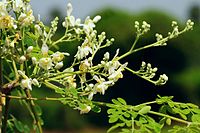
Photo from wikipedia
In this study, genetic diversity and structure of 474 cultivated and 19 wild lablab (Lablab purpureus) accessions. were determined using 15 nuclear and 6 chloroplast SSR markers. The overall gene… Click to show full abstract
In this study, genetic diversity and structure of 474 cultivated and 19 wild lablab (Lablab purpureus) accessions. were determined using 15 nuclear and 6 chloroplast SSR markers. The overall gene diversity was relatively low (0.3441). Gene diversity in the wild accessions (0.6059) was about two-folds greater than that in the cultivated accessions. In the wild accessions, gene diversity was greatest in the southern Africa, followed by East Africa. In the cultivated accessions, gene diversity was highest in the eastern Africa. The results suggested that South Africa is the center of origin and East Africa is the center of domestication of lablab. Different cluster analyses showed that 2-seeded-pod cultivated accessions (ssp. uncinatus) were clustered with wild accessions and that 4–(6)-seeded-pod cultivated accessions (ssp. purpureus and bengalensis) were intermingled. UPGMA tree suggested that ssp. purpureus and bengalensis were domesticated from 4-seeded-pod wild accessions of southern Africa. Haplotype network analysis based on nuclear SSRs revealed two domestication routes; the ssp. uncinatus is domesticated from 2-seeded-pod wild lablab (wild spp. uncinatus) from East Africa (Ethiopia), while the ssp. purpureus and bengalensis are domesticated from 4-seeded-pod wild lablab from Central Africa (Rwanda). These results are useful for understanding domestication and revising classification of lablab.
Journal Title: Plants
Year Published: 2022
Link to full text (if available)
Share on Social Media: Sign Up to like & get
recommendations!